I had the pleasure to sit down and talk with the one-and-only Paula Robison in September. Her new album, Caprice is a kaleidoscope of sound, color, and artistry. Thank you to Paula for your contribution to the flute community. What a wonderful gift you’ve given us with your new album!
-Amanda
Amanda: How did you decide on programming Caprice? I am curious why you chose the Boulez Sonatine.
Paula: When Paavali Jumppanen, the amazing Finnish pianist who plays with me on the album, heard the completed version he said it sounded like a narrative.
It speaks from beginning to end and somehow the order we decided really worked. The inspiration was… friendship. Many wonderful things happen because of the friendship between two artists or a group of artists. In this case, Paavali and I; He has a beautiful career and an interesting one as a person as well as a pianist. We became friends because he played at the Spoleto Festival, where my husband and I were co-directors of the noontime chamber music concerts. I always loved Paavali’s playing.
Then one day he said to me, “You know, Paula, we should play the Boulez Sonatine together.”
I said, “…Never, please, no!”
I said this because during my whole life, I had gone back and forth, deciding to play the Sonatine and then putting it carefully back on the shelf because it was so terrifying. I had worked with Boulez and played his music before—it was always so challenging. There are some people who play Boulez beautifully AND easily because it is natural for them. But for me, his gestures… and the way his music spoke to me, I found it daunting. Technically, the Sonatine was so challenging that I kept putting the music away.
Then in exasperation, Paavali said to me,
“you know, you play the flute …and here is one of the greatest composers of the 20th century who wrote a piece for you. You must play it.”
So, he didn’t give me a choice. He kept hounding me, asking when we were going to play the Boulez Sonatine. This went on for probably a year. I finally gave in. I started to learn it and it was just huge! But he was right there with me… learning it, too. It was the first time that he ever played it though he had worked with Boulez more recently than I had. Finally, we just sat down and we started going through it.
We performed it a few times. The first time we went on stage, and I looked at him and at the music, and I couldn’t believe what was happening! I don’t know if you have ever seen Gary Larson’s cartoon with an elephant sitting at the piano at a concert about to play, saying to himself “What am I doing here?? I am a flute player!?” That’s just how I felt …. “WAIT A MINUTE: THE BOULEZ SONATINE???”
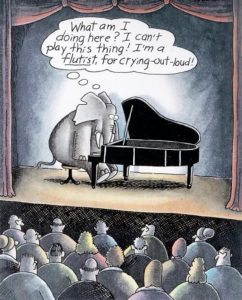
Paavali—with his wonderful Finnish ironic sense of humor—was quite funny and low key during our early performances. We kept playing it, and I slowly started to love it. I began hearing it differently over time. I think Paavali was especially insistent about us learning it together, because he felt the tempi were marked so fast that you couldn’t hear a lot of the inner workings of the piece. Boulez loved the very fast tempi, but Paavali insisted on our tempi sometimes to be slower. In doing so, we evoked the fantastical counterpoints and humor of the piece—let me explain.
There are certain parts, for example in the beginning of the work, that are difficult to get exact because the introduction starts very freely “Tres Librement…Lent” and then suddenly starts to move fast with the direction to be “Très marqué-violent,” and then later an even faster tempo saying “Tempo Scherzando, Avec humeur” (I always imagine Boulez’s wry smile in all of the scherzi).
I think the most challenging parts in the Sonatine are the fast parts—specifically, the rhythms. The rhythms are so juxtaposed. You will play two notes out of a five-note group and then the piano will play two notes. Then you play the rest. All of this is happening at a fast tempo while four other things are also going on. But, when the piece rushes you lose a lot of the small details. We hoped that by bringing out rhythmic complexities, we could make some more of that clear. There was no faking allowed. There’s a ton of faking opportunities in the piece… and many people fake because they want to sound impressive, but the thing is, that this piece is insanely funny if played correctly. Boulez was mocking a lot of what was happening at the time.
He was being such a bad boy! That is what we wanted to express through the music.
Amanda: I think it’s a hard piece to understand. I think you are right…If you think of it with a lighter perspective, it becomes more approachable!
Paula: Yes, a lighter perspective. But, you also have moments that are extremely beautiful and moments which are extremely powerful. There is so much color in it.
After some time, we decided to record it and make the Sonatine the highlight of the album. In honor of Boulez, we wanted to surround his piece with music by French composers. First of all, with Debussy who Boulez worshipped. I played many performances with him conducting Debussy during the 1970s and 1980s. He had a way of getting right to the heart of the music and understanding it in a very special way: very precise, not sentimental…just as Debussy would wish, I am sure. Then we wanted to include Thierry Lancino, who is a composer living New York, but is very Parisian French. He worked with Boulez at IRCAM, and they became good friends. He had written a series of Caprices and we wanted to include him in the album to be an homage to that relationship between the two composers.
Amanda: Tell us a little more about Thierry Lancino’s Caprices.
Paula: I first met Thierry because he and his wife live in the same building where we have an apartment in New York. I was practicing one day and he just knocked on the door and we struck up a conversation. I knew his wife Kristin for many years before, and they are absolutely magical people.
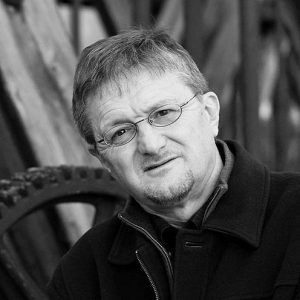
Thierry was working at that time on his Requiem. It is a masterpiece, the Requiem, and it is highly contemporary, but also mixed in with a particular medieval French style. I could almost hear the instruments and the singing from the time as I first heard the Reqiuem. I heard the same thing in the Caprices –They are called Caprices but ironically because they are very dark! There is one movement that reminds me of the 14th century plague pandemic. I think of Ingmar Bergman’s film, The Seventh Seal. The first movement is so magical—like being in a church and hearing the church bells and the spirit rising through the sound of bells calling. The second movement is more narrative, but beginning with the third movement, the music becomes dark and kind of evil! The fourth movement, “Sombre et Mysterieux“, is the one that reminds me of the plague, and finally the last movement is like hell fire… like “HELP!!! Get me out of here!” He was clearly influenced by Messiaen’s music, too, especially in the radiance of the 1st Caprice.
Amanda: It seems like all of these pieces have such a strong narrative. How did you approach the Messiaen’s La Merle Noir?
Paula: For me, it was very important to play the cadenzas not like a flutist, but as close as I could to the sound of bird calls.
This was so important to the composer. Messiaen believed that the bird call is the closest hint we have in this life to what the harmonies of heaven might sound like. This is what he said in his preface to the Quartet for the End of Time. At the beginning of the Le Merle Noir you hear the low low polychord in the piano, which is like the first light of day. Just when you want to stay in bed because it’s 4 am, you hear that annoying bird…. there it is right in your window! So the cadenzas need to be pure bird song. Then the other sections are like the poet thinking about the bird, contemplating the bird in some spiritual sense. I did a “Flutings” video that I ask my students listen to before they play the piece.
Amanda: What was the recording process like? For example, who was your engineer, where did you record, etc…
My husband Scott Nickrenz is the curator of music at the Isabella Stewart Gardner Museum in Boston. They gave us special permission to record in the beautiful Renzo Piano-designed Calderwood Hall in the museum’s new wing.
The Gardner Museum is one of the most extraordinary historic places in this city. The original house is a kind of a palace that was made into a museum. Isabella Stewart Gardner loved music. For many years, concerts were held in the Tapestry Room, which had great tapestries on the walls. Recently, the museum was expanded to include a new wing—including the Calderwood Hall. The museum commissioned Architect Renzo Piano for the expansion. I think it is one of his greatest works. Everyone can see each other in the hall regardless of where they are sitting—It’s inspired by traditional Italian Concert Halls, especially the Teatro Caio Melisso, where we used to play our concerts at the Spoleto Festival. It is truly magical.
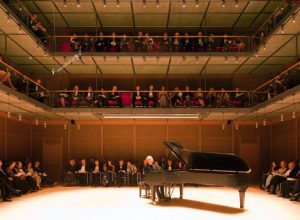
The audio engineer was Tom Stephenson. He is a GENIUS! We recorded the entire CD in Calderwood Hall. It is a remarkably clear acoustic and we could hear everything, but I had a problem with Syrinx when I heard it afterwards. Syrinx was the only track that sounded too“present” because of the position of the microphone. After all, Pan plays from far away! I asked Tom, “Can’t you put me in some other place?” Sound engineers can do that. And, he did! He changed the acoustics of the track to sound as if I were in A little chapel he had found in Lithuania. Strangely enough, I actually have a lot of Lithuanian blood! It was a very odd, reverberant cell…like a cave. I felt my heritage both from my ancestors and from Pan! He showed me a picture of the chapel with blue paint on the walls. It was perfect! So, that is why Syrinx sounds a little different.
Amanda: You have done quite a few recordings and I am curious what kind of advice you give to those interested in looking to do the same. I feel the music industry is always changing—and often times not for the advantage of the classical music artist.
Paula: I don’t know. It really troubles me.
I personally made a decision to make this album and then I am doing one more. That is the last one. I think the form may be disappearing. People are not collecting hard-copy CDs so much anymore. But, it looks like the books are kind of hanging in there. That makes me happy. I love books and turning the pages.
On the positive side of things, there are so many different kinds artists in the world now. The fact that we have a complete collision of cultures now is something so marvelous. By igniting all kinds of ideas and then combining them, you end up with a whole different kind of a creation. One has access to so many musical forms through the internet. You are able to hear tribal music from Sudan, Irish fiddling, or any type of music from around the world. There are so many sources available to you as a performer or a composer.
Amanda: The internet is certainly changing how we consume music. Many times we are so passive because we have so many options in front of us! How do you think people should listen to your album?
Paula: Some albums are great to have playing when you are cleaning your house or doing something else or when you want to dance. My husband and I talk about listening a lot.
We have recordings from 50 years ago where you put them on and you have to sit down and listen. You can’t talk about anything else while you are doing it. Elisabeth Schwarzkopf is a perfect example of this and is one of our favorite artists. Once she starts singing that’s it! You must listen!
For Caprice I recommend that people sit and listen to the whole album. But, that’s a lot to ask. We just don’t do that anymore in these times. People listen as if they are on spaceships. Sometimes, while listening online, people don’t even know the artist who is playing. That is really strange to me.
I think there is something marvelous about sitting down and having the patience to listen to a piece for 20 minutes. Not passively listening, but actively listening. And then listening again! That helps you to know the piece before you jump in at some future time, and makes the experience so much richer. Art has the power to change us, to help us grow…
Amanda: What evoked your creative flow while making the album?
Paula: Sometimes it takes a Finnish pianist! I am an American artist and he is a Finnish artist. We were able to take this music to another level. Upon listening, you can tell that we are not French artists playing. There is something that is different about it.
I like that it is not specifically American or European or anything. It’s just Paavali and me making music. I had so many wonderful people working by my side while making the album. For example, my husband said, “okay, use the [Gardner] museum,” which had never been used for recording. Renzo Piano [The architect of Calderwood Hall, the location where Caprice was recorded], is a good friend of my husband, and I got to know him a little bit when he was building the hall. Then, we were working with Tom, the audio engineer who is a genius. He records all the concerts at Calderwood Hall and knows it really well. Paavali was able to go to Hamburg and chose the Steinway, the Hamburg Steinway that we used during the recording. My sister took the photograph that is on the cover. A former student of mine, Alicia Mielke, who is now concert manager at the museum working with my husband Scott, was the associate producer for the album. One of my current students, Allison Poh, turned pages. We were all together—there were all kinds of different ages, life stories and relationships thriving during the creation of this album!
Paavali and I did all of the first edits. We were editing right away from the beginning. Sometimes producers will make the first edits for the artist. But, we did… and we drilled each other! We were going back and forth by email or by phone, and we met in Boston …then I’d go to the engineer for help. Then we finally got it!
Sometimes it seemed that we’d never get the album released. We worked so hard, it took a long time to edit it, people were getting sick and there were delays, and then finally we got our first box of CDs from the disc makers, and I opened it up and put a CD in the player. Nothing was on it. All of them had to be sent back. There were many situations like this that seemed to happen during the course of this project—but we remained strong and kept moving forward. We were just so passionate about the greatness of the music and wanted it to be born in this form!
I would say, that ABOVE ALL what made this album so special was the amazing Paavali Jumppanen: his great playing, his intelligence, his humor, his incredible artistry!
Purchase Paula Robison’s new album Caprice at Flutistry Boston, CD Baby, or Amazon.
Click image below for more information.
About Paula (taken from PaulaRobison.com)
“Her name is inscribed in the history of her instrument” —Fanfare
Paula Robison, recognized early as one of the great solo flutists of her generation, is celebrating a career of over fifty years this season starting with a birthday appearance on The Late Show with Stephen Colbert dancing to “Tico Tico” and sitting in on flute and piccolo with the show’s stellar band: Jon Batiste and Stay Human. She was born in Tennessee to a family of actors, writers, dancers, and musicians, and studied at both the Juilliard School with Julius Baker and the Marlboro Music Festival with Marcel Moyse (making her a direct musical descendant of the great Paul Taffanel). When she was twenty, Leonard Bernstein invited her to solo with the New York Philharmonic. When she gave her New York recital debut under the auspices of Young Concert Artists, the New York Times wrote: “Music bursts from her as naturally as leaves from trees”. Soon after that she became the first American to win First Prize in Flute at the Geneva Competition, and her international career was launched. Ms Robison was a founding member of the Chamber Music Society of Lincoln Center and held the title of Artist Member for twenty seasons. During the same time she gave a sold-out annual three-recital series at Alice Tully Hall in New York, and served as co-director with Scott Nickrenz for the Chamber Music Concerts at the Spoleto Festivals, presenting many great artists early in their careers and earning the Adelaide Ristori Prize and the Premio Pegaso for her contributions to Italian cultural life, as well as honorary citizenship for life of the City of Charleston, SC. A passionate advocate for new music, Paula Robison has commissioned works by Leon Kirchner, Toru Takemitsu, Robert Beaser, Kenneth Frazelle, Oliver Knussen, and Lowell Liebermann, and premiered music by Pierre Boulez, Elliott Carter, William Schuman, Michael Tilson Thomas, and Carla Bley, among many others. “With Art”, an ongoing series with visual artists, has included Sol LeWitt and Mozart in a special installation at the Isabella Stewart Gardner Museum in Boston, Luciano Berio with art from the 1950s at PS 1 in New York, Jim Schantz in Jerusalem, twenty years of Vivaldi performances in the magnificent Temple of Dendur of the Metropolitan Museum of Art, Toru Takemitsu’s mysteries in the Isamu Noguchi Garden Museum, and a battle with Tim Hawkinson’s UberOrgan at MASS MoCA. In March of 2015, Ms Robison and pianist/celestist Bruce Brubaker performed Morton Feldman’s epic 3.5 hour work “For Christian Wolff” on four successive Monday afternoons in Calderwood Hall, Boston. Listeners were free to come and go quietly, but most stayed to experience the entire life-changing masterpiece. Brazilian music has been central to Ms Robison’s playing life, and she has had the delight of performing, touring, and recording with guitarist Romero Lubambo and percussionist Cyro Baptista as the RLB Trio. She also had the honor of making music with the legendary Altamiro Carrilho and his ensemble in Rio de Janeiro. Paula Robison’s historic recordings for Vanguard Classics were recently reissued, including “The Art of Paula Robison”, a collection of Vanguard favorites. Ms. Robison has also recorded for Sony, Mode (the complete Berio Sequenzas, awarded the Premio del Disco Amadeus 2008, and Lei Liang’s “In Praise of Shadows”), New World Records, King Records, MHS, and Bridge Recordings (her Marlboro Festival performance of Schubert’s Introduction and Variations with Rudolf Serkin, named American Record Guide’s Best Recording of the Year). In 2006 she founded Pergola Recordings, an independent label. Recently released: “Paula Live”, an album of live performances with pianists Jean-Yves Thibaudet, Timothy Hester, and Yefim Bronfman, “Playing New York” with pianist Steven Beck, and “Caprice”: an album of French music featuring a Thierry Lancino world premiere and Pierre Boulez’s “Sonatine”, with acclaimed Finnish pianist Paavali Jumppanen. Her recording of Robert Beaser’s “Mountain Songs” with Eliot Fisk has become a classic of the flute and guitar repertoire. Paula Robison’s teaching has taken her all over the world. Her books on the art of flute playing are published by Universal Edition, Schott, European-American Music, Theodore Presser, and G. Schirmer. Ms Robison was awarded a DMA honoris causa from San Francisco Conservatory of Music, and now holds the Donna Hieken Flute Chair at New England Conservatory. Each summer she joyfully returns to The Interlochen Flute Institute and to the Centre d’Arts Orford to give masterclasses and workshops. Paula Robison is grateful for her husband Scott Nickrenz, Abrams Curator of Music at the Isabella Stewart Gardner Museum, for their daughter Elizabeth Fein, Ph.D University of Chicago, now assistant professor in the Department of Psychology, Duquesne University, for her loving extended family, for her supporters and listeners who said early on to a female flute soloist “Yes, you can”, for her inspiring fellow players and teachers, and for her students through all these many years and now continuing to the future, all of whom have found and are now finding ways to make our world a better and more beautiful place with their music.

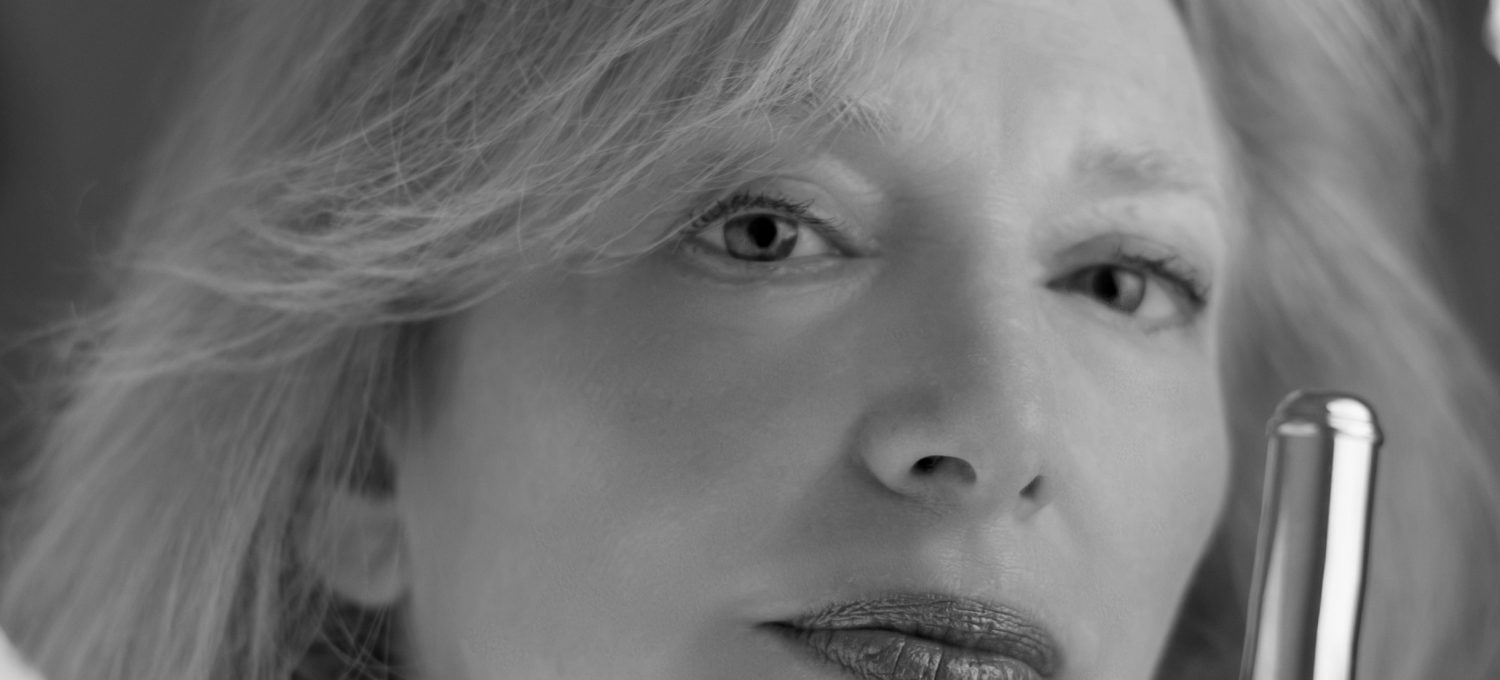
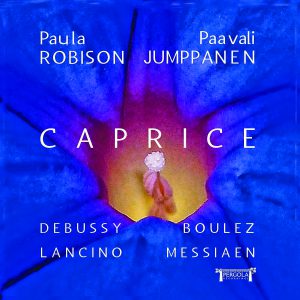
[…] Excerpted from Paula Robison Talks About Her New Album, the Art of Listening, and Boulez’s Sonatine […]